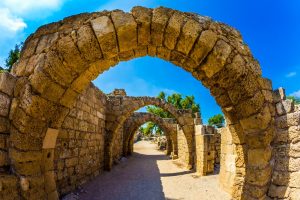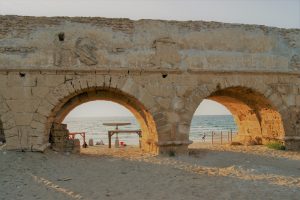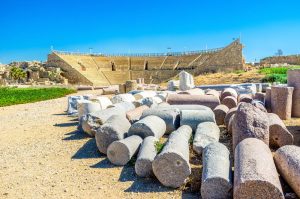Caesarea is one of the most beautiful places in Israel that deserves to be visited, being a marvellous national park with incredible and unique ancient harbour ruins. It is one of the best locations to see in the Middle East, and it was an ancient Herodian port city on the Mediterranean Sea, located between Tel Aviv and Haifa. The uniqueness of Caesarea is because this city is one of the most attractive and breathtaking locations in Israel. The historical and beautiful amphitheatre of Caesarea has been restored, and nowadays, it hosts several concerts in the summertime. Another attraction of Caesarea is its Old City, which owns fantastic shops and restaurants. The new town is a lavish neighbourhood with luxurious villas close to the stunning Caesarea Aqueduct Beach, one of the most beautiful beaches in Israel. It is convenient to rent a car to enjoy your stay in Caesarea; nevertheless, there are many organised tours around Akko, Caesarea, and Haifa.

One of the locations that everyone should visit is the Caesarea National Park, which is one of the most ancient and magnificent in Israel. The beautiful old harbour is a restored masterpiece dating back to King Herod’s kingdom. Visitors can enjoy a tour exploring all the beautiful corners of this location and benefit from a history multimedia guide about the port chronicles. There is a restored amphitheatre in the Park where concerts occur during the summertime. The Harbor Beach is also inside the Park, and it is an extraordinary location perfectly equipped.

Additionally, a unique underwater museum is located inside the Park. It is the only underwater museum in the world where it is possible to dive through the ancient underwater ruins of Caesarea. To enjoy a tour of this marvellous submarine museum, you can contact the Caesarea Dive Club. Another fantastic place in Caesarea is the Aquaduct Beach, which is one of the most beautiful and superb beaches in Israel. This enchanting place owns its name to the ancient Aqueduct located on the beach’s rim. This beach is unique because of the spectacular archaeological ruins and the countryside environment. A peculiar place in Caesarea is the Ralli Museum, one of the five museums in the world, which was founded by Harry Recanati, a Jewish banker and philanthropist with a passion for arts. Indeed, Harry Recanati was a very passionate art collector of art and Latin American art. The five Rally Museums are located in Punta del Este (Uruguay), Santiago (Chile), Marbella (Spain), and two museums are in Caesarea (Israel). The two Ralli Museums in Caesarea are dedicated to Latin American and Sephardic Jewish art. The Caesarea Golf Club is located close to the art museums, and it is the only full-size golf course in Israel, which Pete Dye, a well-known designer, restored. In this area, many good restaurants serve fresh food and seafood with beautiful landscapes over the Mediterranean Sea. Caesarea has a unique charm in the afternoons and evenings in the summertime, mainly because of the sunsets, and it is an excellent place to enjoy a delightful meal starring at sea. The Caesarea National Park is reachable by organised tours of Caesarea from Jerusalem or Tel Aviv.

Moreover, there are many tours, which include a stay in Haifa and Acre. There are many options to reach Caesarea, such as by train, bus, or joining an organised tour. It takes only 1 hour to get to Caesarea by car starting from Tel Aviv. Besides the organised tours, which are the most convenient option, it is possible to get to Caesarea by bus from Haifa or Tel Aviv or Hadera.
Historical Chronicles of Caesarea
The significant discovery of the archaeological ruins of Caesarea occurred between the 1950s and 1960s when the Roman theatre and the fortifications of the Crusader city were found. Several expeditions have been performed in twenty years, and many historical remnants from the Roman and Crusader periods came to light.
The Roman city of Caesarea
Caesarea was founded in the first century BCE by King Herod in the location of the former town Strato’s Tower, which was a former Greek and Phoenician trade post, and named Caesarea in honour of Augustus Caesar. The Jewish historian Josephus Flavius described the city as a walled town with the biggest harbour on the easter Mediterranean coast, which was called Sebastos after the Greek name of emperor Augustus. The temple of Caesarea was devoted to Augustus Caesar with a high podium facing the harbour, and broad steps led from the pier to the temple. The ancient city of Caesarea was flourishing and characterised by entertaining structures, imperial style buildings and the King Herods Palace erected in the southern area. Starting from the year 6 CE, Caesarea was the headquarters of the 10th Roman Legion and the Roman procurators of Provincia Judaea. The city of Caesarea extended, becoming one of the major cities in the eastern Roman Empire between the 2nd and 3rd centuries. In the southern area of the ancient Roman city of Caesarea, the Herods palace was constructed on a rocky spur, and the original complex dimensions were 110 x 60 m with a pool and porticoes. The theatre was also built on a semicircular structure of vaults in the city’s southern area facing the sea at the behest of King Herod. It is one of the former entertainment buildings of the Roman Empire during his kingdom with 15000 seats, and a marble floor characterises this beautiful amphitheatre, which was mainly used for racing horses and chariots, being a real hippodrome. In the second century, the amphitheatre was restored, and it became a standard theatre. Moreover, during Herod’s kingdom, the construction of the Aquaduct took place to supply the city with abundant water originating from the foot of Mt. Carmel. As soon as the town grew, the Aqueduct was widened; in some parts, it was supported by arches, introducing the water into the city through pipes in fountains and pools, which stored the water.

The Byzantine period of Caesarea
Caesarea was a well-known Christian centre during the Byzantine domination since the Church Father Origen had founded a Christian academy in Caesarea with an extensive library containing thirty thousand manuscripts. Moreover, in the 4th century, the theologian Eusebius became the Bishop of Caesarea. He wrote his Historia Ecclesiastica, a colossal geographical and historical study of the Holy Land starting from the beginning of Christianity. Caesarea was encircled by a long wall measuring 2.5 km, which protected the residential quarters outside the Roman city during the Byzantine kingdom. Moreover, a 3 metres wide gate was built in the city’s southern area, which Christians, Jews and Samaritans inhabited, being Caesarea full of churches and synagogues. The Martyrion of the Holy Procopius was the main church in Caesarea, and it dates back to the 6th century when it was built above the ruins of a Roman temple. The Martyrion octagonal church was characterised by marble slabs floors, Corinthian capitals embellished with crosses, with rooms along the walls.
The government building was an imponent and embellished construction located in the city’s centre. It included several rooms, courtyards and a row of vaults ornated by beautiful paintings depicting Jesus and the apostles. The government building had a big entrance with the function of a hall of justice with Greek inscriptions, and some of the rooms had decorative mosaic tiles on the floor.
Another fantastic ancient building of Caesarea was the 5th century-old synagogue in the northern seashore of the port. The synagogue was a rectangular building facing south towards Jerusalem. Among its ancient rests, there are capitals decorated with candelabra, a column with Hebrew inscriptions such as shalom, and a list of the twenty-four priestly courses in the Jerusalem Temple, which were the groups of categories of Jewish priests based on their services in the Temple.
Moreover, in Caesarea, there are several remains of different imponent buildings, such as a complex and embellished 4th-century bathhouse, which consisted of several rooms and courtyards distinguished by paved walls with mosaics. Another beautiful feature of the bathhouse was the caldarium area, which consisted of a series of hot rooms with a heating system named hypocaust, floored with marble paving and decorated with mosaics on the walls. Later, a two-floor palace was built inside the amphitheatre with a staircase linking the two floors. On the upper level, there was the residence with two courtyards and rooms decorated with mosaics and colourful tiles; meanwhile, on the lower floor, there was a courtyard with columns, marble rood arches, and a fountain since the lower level was an open garden.
Arab Caesarea
After the conquest of Caesare by the Arabs in 639, the city’s importance diminished and the number of inhabitants. Most of the urban areas were transformed into agricultural terraces. In the 10th century, the Arab town was encompassed by a 3-metres thick wall, which archaeologists discovered.
Crusader Caesarea
King Baldwin I conquered Caesarea with his Frankish army, which became an archbishop seat and a settlement for eastern Christians and Muslims, besides Franks. During this period, the Genoese merchants and travellers discovered a green glass goblet in Caesarea, identifying it with the Holy Grail, the chalice that Jesus used in the course of the Last Supper. Hence they brought it to Genoa and kept it in the Church of San Lorenzo. After Saladin had sieged Caesarea in 1187, Richard the Lion Heart, King of England, conquered the city, expelling the Muslim residents. Between 1251 and 1252, the King of France, Louis IX, rebuilt Caesarea and surrounded the city with an imponent 4-metres thick wall and a total length of 1.6 kilometres wall encompassing 40 acres.
Additionally, Caesarea was protected by towers, glacis and a moat, 10 meters deep and 15 metres wide. A system of gates allowed access to the city, and the main entrance was on the eastern wall through a bridge supported by arches lying on piers at the bottom of the canal. The gatehouse had a vaulted ceiling supported by consoles embellished with floral decors. Wooden bars were used to close the doors from the inside, and an iron grill protected the outer side of the doors.
Another important and impressive construction of the Crusader period was the 12th-century cathedral of the Crusader city, which was erected on the podium built under King Herod’s kingdom as an acropolis. The cathedral’s dimensions were 55×2 metres, and its hall consisted of a central nave and two aisles extending up to the east in three apses. The floor was decorated with mosaics, and rectangular piers and pilasters supported the vaulting. In 1265, Mamluk Sultan Baybars attacked the city, and the crusaders abandoned Caesarea. After that, the Mamluks destroyed all the city’s fortifications.
Hence, it is well-known that Caesarea is one of Israel’s most beautiful and unique archaeological locations. Indeed, there are many places to visit in Caesarea, such as King Herod’s palace, the Roman theatre, the amphitheatre, and much more.

The Underwater Archaeological Park of Caesarea
The Underwater Archaeological Park of Caesarea is absolutely a unique place in the world because it is the only underwater museum in the world where it is possible to dive through the submerged ruins of the ancient city of Caesarea. During the King Herod Kingdom, the construction of Sebastos took place, and the intention to build the harbour of Caesarea Maritima was to create a primary port for the shipment and commerce of opulent goods that originated from the Indian Ocean up to the Mediterranean Sea. Among those products, there were cosmetics, drugs, spices, textiles and exquisite stones, which were mainly traded during the kingdom of Augustus Caesar. The harbour of Caesarea was built between 22 and 10 BC at the behest of King Herod. Hence Caesarea became a diplomatic and financial centre in the Middle East. After a period of obliviousness, the port began again to flourish starting in 1960, and significant research started in 1975 thanks to the Center of Maritime Studies at Haifa University under the supervision of Professor Avner Raban, who launched the underwater park project in 1992. Caesarea port is the oldest harbour built following Vitruvius’s requirements; hence, it is the first vast scale artificial harbour in history and the most modern and extensive one in the entire Roman Empire of that period. Visiting the underwater Herodian harbour in Caesarea is an extraordinary and breathtaking experience, combining the natural beauty of the submarine environment of the Caesarea Maritima area with the wonderful ancient vestiges of the harbour.

All the treasures of Caesarea
Caesarea is a jewel in the Mediterranean Sea and one of the most magnificent locations in the coastal area of Israel. Visitors can enjoy their time among ancient vestiges, trendy cafeterias, exquisite restaurants, luxurious beaches with white sands and crystalline waters.
The first place to visit in Caesarea is the national park, where ancient buildings dating back to the Roman empire are located. In the Roman Theatre often interesting musical performances and shows take place with a stunning view of the Mediterranean Sea. It is an open Roman theatre with ancient stone benches.
It is possible to combine the visits to different places such as the ruins of the castle, the towers and city halls, temples, the hippodrome where time to time, horse races occur, the ancient harbour with the artists’ square, and of course the Underwater Archaeological Park of Caesarea.
Caesarea is a location that is very rich in history and art, and its reconstruction dates back to 22 BC at the behest of King Herod. Later, the city was renamed Caesarea in honour of the Roman emperor Augustus. Some archaeologists hypothesised the theory of a flood provoked by a tsunami, which submerged the ancient city whose ruins are located in the underwater park, and visitors can admire them whilst diving and snorkelling. Moreover, in the port of Caesarea, many cultural festivals occur during the year, and several activities offer any kind of entertainment, such as yoga on the beach, jeep tours, and tours in food and craft markets. Caesarea beaches are unique places for their fantastic beauty, being also the perfect spots for scuba diving and snorkelling, especially in the underwater archaeological park with its breathtaking ancient vestiges beside the port. In Caesarea, there are public and private beaches, and among the public ones, the Aqueduct beach is well-known for the famous Roman Aqueduct and the magnificent and calm coastline. Dating back 2000 years ago, the Roman Aqueduct had the function to bring water into the city. Delicious fresh local food is always servent at every restaurant in the city, in particular seafood and fish, besides the many amazing cafes, cocooning spas, impressive museums such as the Ralli Art Museum, the magnificent ancient palace and elegant hotels. And it is important to remind that since 2000, the archaeological site of Caesarea Maritima has been a UNESCO World Heritage Site in Israel, and it is the site where the ancient palace is located, characterised by magnificent mosaics dating back to the 6th-century and made of glass gold and coloured opaque glass tesserae, which are tiles with a squared shape, also known as abaciscus or abaculus, and used as a table often patterned with rosettes and crosses.

Hence, Caesarea is a must-see location full of entertainment, history, archaeology, nature, art, beauty, delicious treats and food, which everyone will enjoy exploring.

